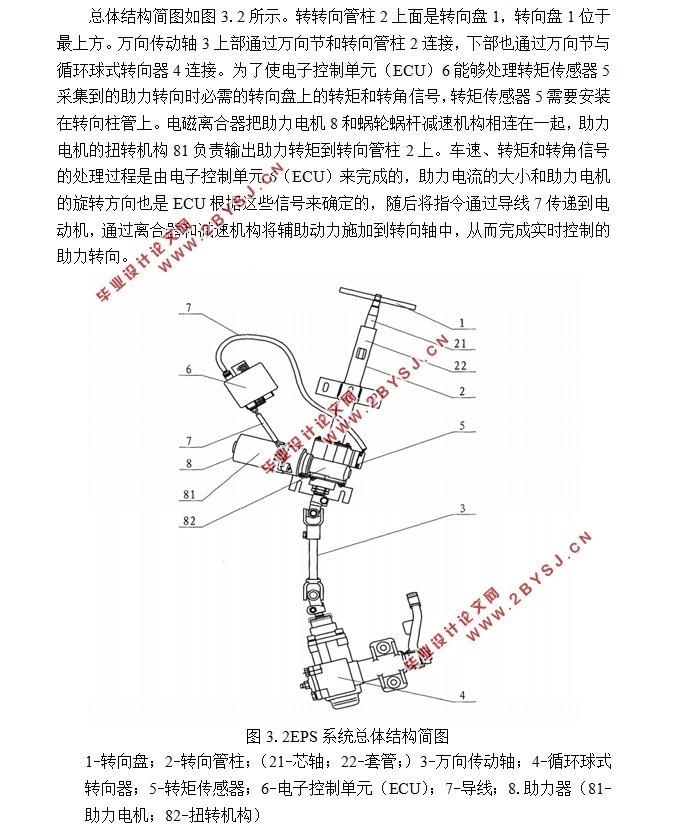轻卡纯电动厢式汽车转向系统EPS结构设计(含CAD零件装配图)
无需注册登录,支付后按照提示操作即可获取该资料.
轻卡纯电动厢式汽车转向系统EPS结构设计(含CAD零件装配图)(任务书,开题报告,文献摘要,外文翻译,论文说明书17000字,CAD图8张)
摘要
在许多城市,由于越来越严峻的环保形式,使用柴油的载货卡车几乎都被取消了路权。在新能源补贴、停车费减免以及享受各种路权的政策鼓励之下,新能源汽车市场成为了一片新的红海。轻卡纯电动汽车就在这样的环境下产生。轻卡纯电动汽车具有路权优势大、补贴力度强、环保和能源成本低等优点,这也使它在城市的物流配送领域里占有越来越多的比例。电动助力转向系统具有节能环保特性高的优点,符合轻卡纯电动汽车的要求。 本文基于电动助力转向系统的许多的优点,所以就以电动助力转向系统为主体进行轻卡纯电动汽车转向系统的设计。本文首先确定了轻卡纯电动汽车的参考车型和它的基本性能参数,以此为基础确定了转向系统的总体方案。然后根据EPS的组成结构进行电动助力转向系统的关键零部件的选型和计算。重点是在分析各种机械转向器性能优劣的基础上,选择循环球转向器进行设计计算和校核,并且在此基础上利用CATIA软件建立了电动助力转向系统的三维模型,并对转向摇臂进行了应力分析。本文中设计结果符合转向系统的基本要求,安全可靠。 关键词:轻卡纯电动;电动助力转向;循环球式转向器;分析
Abstract
In many cities, cargo trucks using diesel have almost been eliminated due to increasingly severe environmental forms. Under the encouragement of new energy subsidies, parking fee reductions and enjoyment of various road rights, the new energy vehicle market has become a new Red Sea. Light trucks are produced in such an environment. Light truck pure electric vehicles have the advantages of large road rights, strong subsidies, environmental protection and low energy costs, which also make it occupy more and more proportions in urban logistics distribution. The steering system is an important system for automobiles, and the requirements for energy-saving and environmental protection of steering systems are now increasing. The electric power steering system has high energy saving and environmental protection characteristics and meets the requirements of light truck pure electric vehicles.
This article is based on the many advantages of electric power steering system, so the design of light truck pure electric vehicle steering system is mainly based on electric power steering system. This paper first determines the reference model of the light truck pure electric vehicle and its basic performance parameters, based on which the overall scheme of the steering system is determined. Then, according to the composition of the electric power steering system, the selection and calculation of key components of the electric power steering system are carried out. The focus is on the analysis of the performance of various mechanical steering gears, the selection of the recirculating ball steering gear for design calculation and verification. Based on this, the 3D model of the electric power steering system was established by using CATIA software, and the stress analysis of the steering rocker was carried out. The design results in this paper meet the requirements, safe and reliable.
Key Words:Light truck pure electric;EPS;Recirculating ball steering gear ;analysis
轻卡纯电动厢式汽车主要性能参数
参数 参考值
电机型号 苏州朗高YQW200Y-10A-RA2
电机额定功率/扭矩 50kW/478N•m
总质量 4495kg
额定载质量 1200kg
整车外形尺寸(长宽高) 5995/2250/3090mm
轴距 3308mm
前/后轴荷 1875kg/2620kg
轮胎型号 7.00R168PR
电池型号 时代新能源DCH3D3
电池容量 99.8kWh
轻卡纯电动厢式汽车转向系统总体设计方案
转向器、转向传动机构和转向操纵机构三大部分组成了机械的转向系统。转向传动轴、转向万向节、转向轴、转向盘组成了转向操纵机构。转向摇臂、转向节臂、梯形臂、转向横拉杆、转向直拉杆组成了由转向摇臂到转向梯形这一部分(不包含转向节)是转向传动机构,转向操纵机构和转向传动机构之间是转向器。
前面已述,纯电动轻卡汽车转向系统采用的是EPS系统,因此与其他的机械转向系统的区别就在于多了转向加力装置。
转向盘
轮毂、轮辐、轮缘组成了转向盘。发生事故时,为了降低转向盘和驾驶员身体的碰撞所造成的的伤害,轮辐应有足够大的面积,而且轮辐多时可以满足强度和刚度的要求。但是也为了驾驶员观察仪表盘更有利清楚,转向盘的轮辐不宜设置过多。,转向盘的轮毂部分设计有内花键,用来与转向轴上的花键配合并固定。




目 录
摘要 I
Abstract II
第1章 绪论 1
1.1 汽车转向系统概述 1
1.2 电动助力转向系统的特点 1
1.3 电动助力转向系统的国内外研究现状 2
1.3.1 国外研究现状 2
1.3.2 国内研究现状 2
1.4 本文研究背景和意义 3
第2章 电动助力转向系总体设计方案 4
2.1 轻卡纯电动厢式汽车的主要性能参数 4
2.2 轻卡纯电动厢式汽车转向系统总体设计方案 4
2.2.1 转向盘 4
2.2.2 转向轴、转向柱管及其吸能装置 5
2.2.3 转向器 6
2.2.4 转向传动机构 9
第3章 EPS总体结构和关键零部件选型 12
3.1 电动助力转向系统的分类 12
3.2 EPS总体结构 13
3.3 EPS关键零部件计算和选型 13
3.3.1 助力电机的计算和选型 14
3.3.2 转向器的选型 16
3.3.3 传感器的选型 16
3.3.4 减速机构的选型 18
3.3.5 电磁离合器的选型 19
3.4 EPS助力特性 20
第4章 循环球式转向器的设计和计算 22
4.1 螺杆-钢球-螺母传动副的设计 22
4.2 齿条-齿扇传动副的设计 24
4.3 转向器计算载荷的确定 27
4.4 循环球式转向器零件强度校核 28
第5章 基于CATIA的有限元分析 31
第6章 结论 35
参考文献 36
致谢 38
